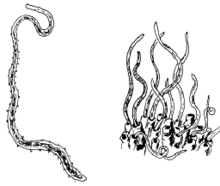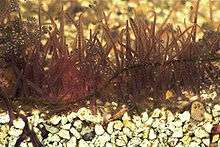Naididae
| Naididae | |
|---|---|
 | |
| Tubifex tubifex | |
| Scientific classification | |
| Kingdom: | Animalia |
| Phylum: | Annelida |
| Class: | Clitellata |
| Subclass: | Oligochaeta |
| Order: | Haplotaxida |
| Family: | Naididae Ehrenberg, 1828 |
| Subfamilies | |
|
Limnodriloidinae | |
| Synonyms | |
|
Tubificidae Vejdovský, 1876 | |

The Naididae (formerly known as Tubificidae) are a family of clitellate oligochaete worms like the sludge worm, Tubifex tubifex. They are key components of the benthic communities of many freshwater and marine ecosystems. In freshwater aquaria they may be referred to as detritus worms.[1]
Description
These worms can vary in size, from centimeters to millimeters, depending on the subfamily. They are all hermaphroditic and lack a larval stage.[2]
Taxonomy
Analysis of 18S rDNA sequences has revealed that the family may not be monophyletic.[3] However, the worst paraphyly was corrected with uniting the Naidinae with the other families. This necessitated a change of names under the International Code of Zoological Nomenclature rules, as Naididae was now the senior synonym of Tubificidae. It was proposed to the International Commission on Zoological Nomenclature to suppress Naididae because the "tubificids" are the more well-known group of the two, but that was rejected.[4]
The Naididae family is divided into six subfamilies, arranged here in the presumed phylogenetic sequence:
- Tubificinae, containing (among others) the genus Tubifex
- Naidinae Ehrenberg, 1828
- Telmatodrilinae Eisen, 1879
- Limnodriloidinae Erséus, 1982
- Phallodrilinae Brinkhurst, 1971
- Pristininae Lastočkin, 1921, often included in Naidinae
- Rhyacodrilinae Hrabě, 1963
Presence in aquariums
In an aquarium, numbers of naididae can increase rapidly. When their population becomes high, the worms migrate toward the surface of the water for access to higher concentrations of oxygen. Although detritus worms may not cause harm to aquarium fish, their appearance is an indication of poor water quality mainly due to overfeeding and lack of good water sanitation.
Improvement of water quality, filtration, gravel cleaning, and the reduction of feeding, may be performed to bring detritus worm population back to normal. Detritus worms feed on excess food and waste, thereby contributing to the ecosystem of an aquarium.
Sometimes detritus worms are mistaken for Planarians or other types of worms.
References
- ↑ http://www.aquarium-pond-answers.com/2007/03/trematodes-and-nematodes-in-fish.html#annelids
- ↑ Brinkhurst, R.O. (1986). Guide to the freshwater aquatic microdrile oligochaetes of North America. Ottawa: Dept. of Fisheries and Oceans. p. 1. ISBN 0-660-11924-2.
- ↑ Envall, Ida; Källersjö, Mari; Erséus, Christer (August 2006). "Molecular evidence for the non-monophyletic status of Naidinae (Annelida, Clitellata, Tubificidae)". Molecular Phylogenetics and Evolution. 40 (2): 570–584. PMID 16684611. doi:10.1016/j.ympev.2006.03.021.
- ↑ Erseus, Christer; Mark J.Wetzel; Lena Gustavsson (2008). "ICZN rules—a farewell to Tubificidae (Annelida, Clitellata)" (PDF). Zootaxa. 1744: 66–68. Retrieved 23 May 2014.
| Wikimedia Commons has media related to Naididae. |